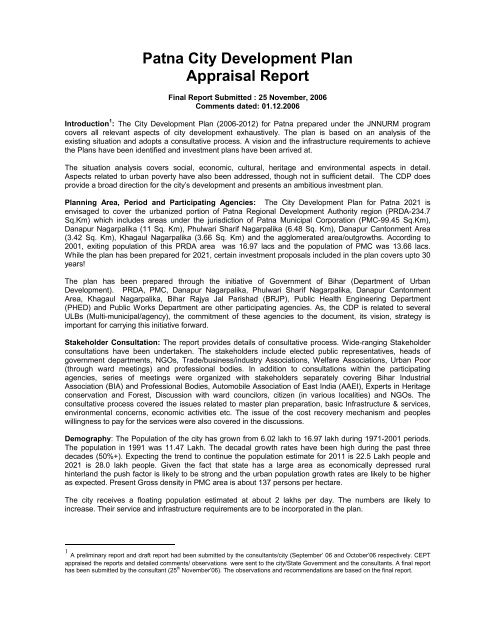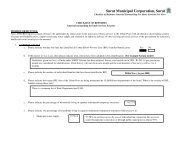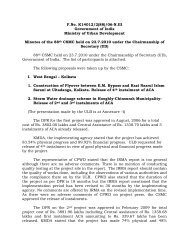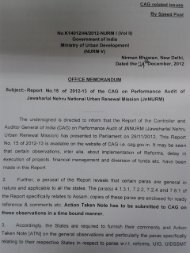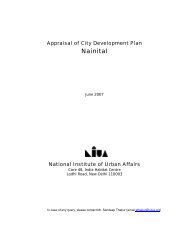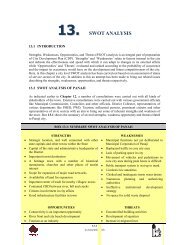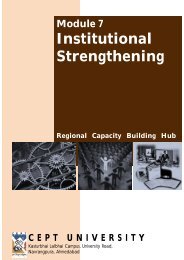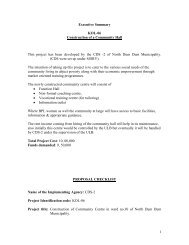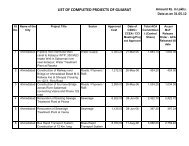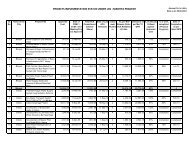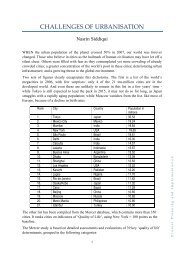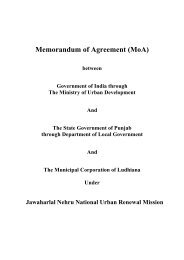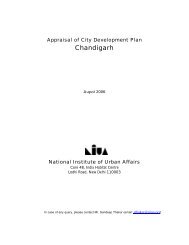Patna City Development Plan Appraisal Report - JnNURM
Patna City Development Plan Appraisal Report - JnNURM
Patna City Development Plan Appraisal Report - JnNURM
Create successful ePaper yourself
Turn your PDF publications into a flip-book with our unique Google optimized e-Paper software.
capita generation of 331 gm/d. The waste is generally disposed on the roads by the households andsubsequently collected by street sweeping staff of PMC. Efficiency of street cleaning is low. The requiredequipments and infrastructure are not available with PMC.There is no disposal site identified by the city for disposal of the Solid Waste. The solid waste collected byPMC finds its way to low lying areas, road sides and other open spaces in unhygienic and unscientificmanner causing risk for health and environmental hazards. The waste characteristics as stated in CDP isputrescible (49 %), combustible (12.5 %) and non-combustible (38.5 %).The estimated quantity of SW for the year 2021 for a population of 28 lacs is 1089 MT/d, as against presentSW generation of about 700 TPD from a population 17 lacs. <strong>City</strong> estimate the total funding requirement forthe SWM at Rs. 92 Cr, covering the primary/secondary collection (Rs. 80 cr.), transportation (5 Cr.) andDisposal System (3.5 cr.). The estimation of equipments appears to be on slightly on higher side.It is notable that the city has proposed to tke-up the SWM on the Public-Private partnership basis.River Front <strong>Development</strong>: The city has conceptualized a River Front <strong>Development</strong> under the head of <strong>City</strong>Environment at total cost of 300 Cr, which is proposed to be taken-up on PPP mode. The current stage ofthe project is only at concept level and needs to be examined carefully in view of hydrological nature ofGanges and Gandkak River. Linkages with storm drainage, sewerage and road network plan is to be seen.Other Projects: The <strong>City</strong> has planned to upgrade the outlook of the city by landscaping and maintenance ofparks, street furniture, sinages etc. at total cost of Rs. 17.00 Cr. Other project proposed are Bus stands,Slaughter house, Dairiy areas, and industrial development at cost of Rs. 50 Cr..Institutional Framework: The CDP document provides details of the functioning of the existing followinginstitutions related to urban governance:• <strong>Patna</strong> Municipal Corporation (PMC)• <strong>Patna</strong> Regional <strong>Development</strong> Authority (PRDA)• Bihar Rajya Jal Parishad (BRJP)• Public Health Engineering Department• Nagar ParishadsThe institutional role and responsibility of various state agencies, parastatal agencies, and municipaldepartments has been attempted to draw a picture on the strengths and weaknesses. PMC is weak and thestate is yet to devolve the responsibilities as per 74 th constitutional amendment. Overlapping responsibilitiesis a major institutional weakness. As understood, main agencies for infrastructure development, servicesdelivery and urban governance are PMC/Nagar Parishads, PWD, BRJP and PHED.It is understood that the several PMC’s positions are vacant or have not been carved out to take care ofproper distribution of work, due to which a significant portion is from the State departments. PMC needs tobe strengthened with more professionalism, staff and other infrastructure so as to perform its responsibilitiesin a more effective manner. There is clear need to strength the capacity of PMC for effective urbangovernance by way of building the professionalism in dealing with the envisaged infrastructure projectsunder the JNNURM.The city has shown keen interest for urban governance related projects such as E-Governance, Mapping,Capacity building and Urban Management Institute, with total cost of Rs. 102.7 crores.• The elections are held regularly. The last elections were held in 2002 and the next election is to beheld in Jan/Feb 2007.• There have been no instances of dissolution, under Article 243U during the past one year or sincethe launching of the JNNURM.• No instance of any hiatus at all between the completion of a municipality’s term of five years and theholding of elections thereafter has occurred.• MPCs have not been constituted• The Ward Committees are not constituted as follow-up of 74 th Amendment of Constitution, insteadthere are several committees to look into the various aspects of PMC’s activities. Devolution ofpowers to PMC fro effective management of affairs in its jurisdiction is under consideration at Statelevel.
• <strong>Plan</strong>ning functions are with PRDA.• Suitable amendment to Rent Control Act and Stamp Duty Acts is under consideration.• E-governance is yet to be introduced.The State Government and PMC are committed to the reform agenda, which has already received theacceptance from state govt. and elected parties/bodies. The Urban Land Ceiling Act has already beenrepealed in the State.Urban Finance: Resource base of PMC is very Low (Revenue 21 Cr. and expenditure 25 Cr.). Of therevenue income of 21 cr. About 17 Cr. is from its own resources and grants contribute to 2.8 cr. The citygenerates 70% of it own income from the property/other taxes and rest from non tax revenue. The revenueand expenditure figures during the last four year remained inconsistent for generating a pattern of financialresource mobilization and utilization by PMC. The revenue income has been declining at the rate of 6%(average).Of the expenditure establishment cost (75%) is high straining the PMC. The revenue expenditure has beenincreasing at the rate of 12% per annum. The O&M expenditure is about 2.2 Cr. (9%) of revenueexpenditure. Total debt liabilities on the PMC are in tune of 14.5 Cr. and servicing of debt is not regular.As per the CDP, the implementing agencies proposed are Government agencies such a PMC, PRDA,BRJP, PWD PHED etc. ??????Capital Investment <strong>Plan</strong>: The city has proposed a total investment of Rs. 3618 Cr over the next five yearsto meet the commitments as per the CDP. The cost will be shared by mechanism PMC, Centre and Sategovt. as per JNNURM norm i.e 30% (PMC), 20% (State) and 50 % (Center). The State government iscommitted to provide the capital investment on part of PMC and is also committed to provide the support tothe O& M of Infrastructure created with the State share.The proposed investment plan is for about Rs. 3600 which has been phased out in 5 years. Of this, theshare of <strong>Patna</strong> Municipal Corporation is Rs. 858 Crores and the state is Rs. 2279 Crores. Of this, Rs. 588Crores and Rs.1971 Crores as sustainable investment levels by the local body and the state governmentrespectively. Projects have been phased out in 5 year period.The city has not made any major infrastructure investments during the analysis period (2001-05) the capitaloutlay by the local body have been meager (Rs. 2 Crores to Rs. 6 Crores). Given the low levels ofinvestments, infrastructure gaps have grown justifying requirement of high levels of capital inputs. However,financial sustenance and absorption capacity is also very limited..The O & M cost is estimated to be of the order of Rs. 107 Cr (page 165), out of which PMC has O& M of Rs8.6 Cr and the rest Rs. 98.4 Cr. is proposed to be borne by the State. While, this model is not sustainable,the proposed support from JNNURM along with reforms will enhance the capacities to be self sufficient.Recommendation: The plan is recommended for approval primarily to provide an opportunity for <strong>Patna</strong> toenhance its capacity and initiate management reforms. The <strong>Plan</strong> should be seen as a way to address theconcerns expressed on sustainability. Following are important aspects to be taken into consideration.1. The estimates of the infrastructure requirements, especially in case of Storm Water Drainage,sewerage/sanitation, Riverfront development and Roads & Transportation seem to be on the higherside. The project components, unit costs and phasing needs to be looked into in detail at DPRpreparation stage.2. The plan is financially not sustainable within the existing institutional arrangements. There is a needto put in place pricing and cost recovery mechanisms and functional devolution as per 74 thconstitutional amendment at the earliest.3. Prioritization of the projects has not been done.4. Projects, especially related to urban transport need to be evaluated in detail with regard to theircompliance with National Urban Transport Policy.5. Focus on urban poor is inadequate.6. Human resource development aspects have to be taken up on priority.7. The local government should revise its CDP within a period of one year incorporating all the issuesidentified in this report.


